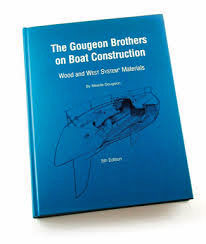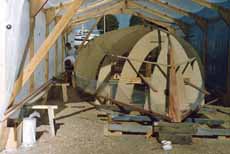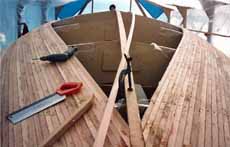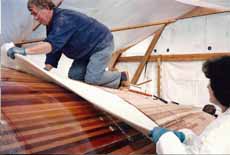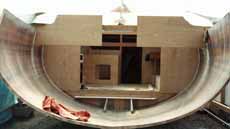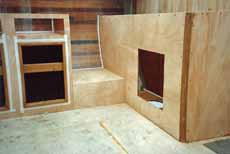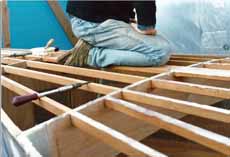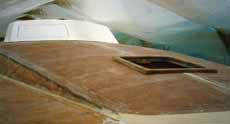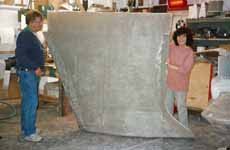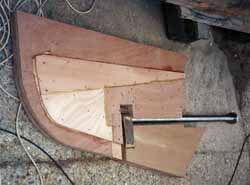- Home
- Build Your Own Boat
- How to Build a Sailboat
How to Build a Sailboat
Knowing how to build a sailboat is one thing, but do you know how to build a shed? Not having access to a large enough building, constructing a temporary construction shed was the first thing we had to do when we set out to build Alacazam, our 'ideal' offshore cruising sailboat.
As a custom-designed one-off sailboat, Alacazam had been designed specifically to meet our requirements for long distance sailing, and living aboard for extended periods.
She would be of medium-to-light displacement, robust, easily handled by a cruising couple - and reasonably quick. But back to that shed...
We won't dwell too long on the shed construction; suffice to say that the uprights were made of 4" by 4" (100mm x 100mm) timber, the trusses of 6" by 1" (150mm x 25mm), the ridge beam of 6" x 2" (150mm x 50mm) and the gusset plates cut from half inch (12mm) ply.
Diagonal wind bracing was incorporated in the ends of the structure to prevent the whole shebang from collapsing in the first stiff breeze.
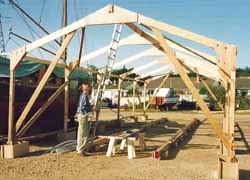 The shed takes shape...
The shed takes shape...Rather than concreting the uprights in pits we built plywood boxes around the bases of the uprights and drove steel pins down into the ground within the boxes.
These were then filled with concrete - that shed was never going anywhere...
Finally we clad it in heavy duty reinforced polythene sheeting, with roll-up 'doors' at each end.
That's it; no more about the shed. We can, in fact, draw a line under it...
Next, the Stillage
This is the rigid structure supporting the temporary frames upon which Alacazam's hull would be built.
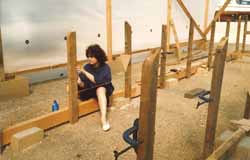 Mary had dark hair before we started...
Mary had dark hair before we started...It had to be absolutely secure, or the hull frames could end up out of alignment - which would have been less than ideal...
The longitudinal timbers were 8" x 4" (200mm x 100mm) timbers held in place by the same concrete block and steel pin technique that we used for the shed.
Before fixing the frames, the centreline was marked on all the horizontal crosspieces using a theodolite, and a horizontal plane on all the uprights with an engineers' level.
Great care had been taken to ensure the uprights were truly vertical and spaced at 1m intervals - and you'll see why this is so important very soon.
Making the Temporary Frames
Alacazam's designer, Andrew Simpson - a man who knows exactly how to build a sailboat, having designed and built several others before this one - developed the hull lines and hydrostats with Vacanti's 'Prolines' design software and created the construction drawings with 'AutoCad'.
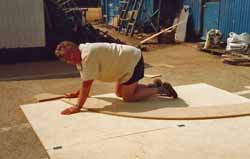 The designer on his knees again...
The designer on his knees again...This package generated coordinates at various cross-sections at 1m intervals (stations) along the length of the hull, and enabled us to mark out full-size templates for the temporary frames on sheets of chipboard.
Making due allowance for the hull thickness, we cut out the templates with a jigsaw and assembled them - glued and screwed - into full-size frames.
Both the centreline and the design waterline were marked on each one, along with the station reference number.
Completing the Stillage
The next stage was to fix the temporary frames to the stillage uprights, preferably in the correct order.
The frames were aligned with the centreline marked on the horizontal crosspieces, and levelled such that the marked waterline was a fixed distance from the horizontal plane marked on the uprights. Every frame was checked and double-checked for level and alignment before being fixed firmly in position.
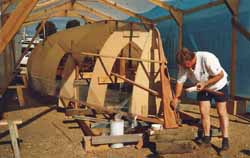 Almost ready to start planking the hull...
Almost ready to start planking the hull...The stem was fashioned from a section of solid mahogany, to which the forestay chainplate would be bolted.
This would eventually have a shaped section of mahogany bonded to it, forming the bow and which would offer some protection to the chainplate in the event of collision.
It was to a degree sacrificial in the event of a coming together, but hopefully it wouldn't come to that.
Now we could see what Alacazam's hull with its pronounced tumblehome would really look like, albeit the wrong way up. What's tumblehome? It's the section of the hull which curves upward and inward towards the centreline.
The shed together with the mysterious goings-on inside created a great a deal of interest in the boatyard. Several curious passersby couldn't resist a peep inside, one of which was kind enough to point out that "it wasn't a good idea to build a boat with chipboard", referring to the temporary frames around which Alacazam's hull was to be built.
"But it's marine grade chipboard", we told him. He seemed happy with that explanation and continued on his way. Clearly it was time to start building...
Next: How to build a sailboat hull in cedar strip...
Recent Articles
-
Is An SSB Marine Radio Installation Worth Having on Your Sailboat?
Apr 14, 25 02:31 PM
SSB marine radio is expensive to buy and install, but remains the bluewater sailors' favourite means of long-range communication, and here's why -
Correct VHF Radio Procedure: Your Questions Answered
Apr 14, 25 08:37 AM
Got a question about correct VHF radio procedure? Odds are you'll find your answer here... -
VHF Marine Radio; Which One is Right for Your Boat?
Apr 14, 25 05:09 AM
If you're looking to buy a VHF Marine Radio the choice can be a bit overwhelming. So what should it be, a fixed VHF or a handheld VHF? Maybe one with AIS or GPS built in perhaps?
